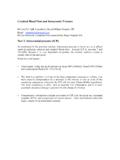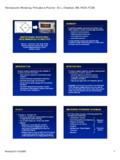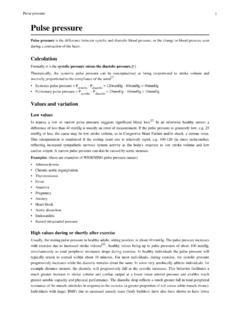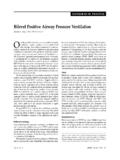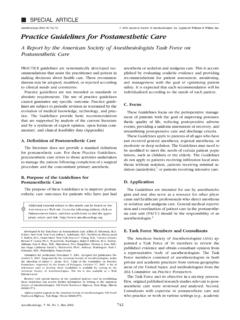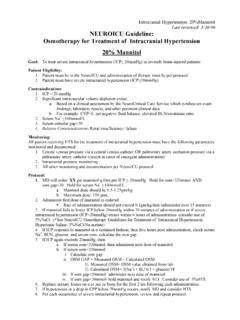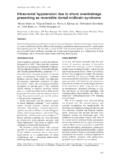Transcription of Review of the role of mannitol in the therapy of …
1 18th Expert Committee on the Selection and Use of Essential Medicines (21 to 25 March 2011). Section 16: Diuretics -- mannitol Review (Children). Review of the role of mannitol in the therapy of children Dr Fatemeh Tavakkoli Pharm. D Candidate, University of Maryland, School of Pharmacy, Baltimore, Maryland, USA Contents 3. Background .. 3. Table 1: available guidelines for mannitol .. 3. Public Health Burden .. 5. Table 2: Indications and dose regimens for mannitol in children .. 6. Search methods for identification of safety and efficacy data .. 7. 8. Systematic 8. Individual studies (categorized by therapeutic use of mannitol ): .. 10.
2 mannitol use in Cerebral Oedema (See Appendix 3, table 4) .. 10. mannitol use in DKA (See Appendix 3, Table 5).. 10. mannitol use in asthma (See Appendix 3, Table 6).. 10. mannitol use in Cystic Fibrosis (See Appendix 3, Table 7) .. 11. mannitol use in other indications (See Appendix 3, Table 8) .. 12. List of clinical trials, listed on , including the use of mannitol or hypertonic saline in children with elevated ICP .. 13. Discussion .. 13. Conclusion and recommendations for the Expert Committee on the use of mannitol in children .. 14. References:.. 16. Appendix 1: Search terms .. 18. Appendix 2: Search strategy and article selection.
3 19. Appendix 3: Data extraction 21. Table 1: William McGuire. 2007. Systematic Review : Perinatal 21. Table 2: Andrew Whitelaw. 2000. Systematic Review : Systematic Review of therapy after hypoxic-ischemic brain injury in the perinatal period.. 22. Table 3: Samson Gwer. 2010. Systematic Review : The role for osmotic agents in children with acute encephalopathies: a systematic Review .. 25. Table 4: mannitol use in cerebral edema.. 27. Table 5: mannitol use in 29. Table 6: mannitol use in asthma .. 31. Table 7: mannitol use in Cystic Fibrosis .. 37. Table 8: mannitol use in other 41. Elevated intracranial pressure , intracranial hypertension, or cerebral oedema is used interchangeably along the text.
4 2. Introduction At its meeting in October 2007, the WHO Subcommittee of the Expert Committee for the Selection and Use of Essential Medicines requested that the role of mannitol in children be reviewed in light of potentially newer and more effective medicines for the next meeting of the Expert Committee [1]. A literature Review was, therefore, undertaken to determine existing evidence for the comparative safety and efficacy for the use of mannitol in children Background mannitol , an osmotic agent, is a naturally occurring sugar alcohol that can be used orally or intravenously. Oral mannitol is used for bowel preparation and intravenous mannitol is used to induce diuresis in clinical situations, such as cerebral oedema and acute renal failure [2].
5 As an osmotic diuretic, mannitol is most commonly used in the intensive care unit [3]. mannitol is currently recommended for the treatment of cerebral oedema and raised intraocular pressure as well as for the assessment of renal function [4]. To identify current paediatric guidelines and recommendations for mannitol , several resources were reviewed including: WHO publications, paediatric and pharmacology text books, the Brain Trauma Foundation web site and publications, WHO regional databases, FDA website, BNF, Australian handbook, and international pharmacopoeias. (See table 1). Table 1: available guidelines for mannitol Source WHO BNF for WHO National Facts & model children guidelines guidelines Compariso formulary 2009 for clearinghous n for essential e children trauma 2008 care Paediatric Yes Yes No No No No specific guidelines Indications Cerebral Cerebral Raised Management Acute renal Acute renal oedema, oedema, intracrania of sever failure, failure, raised raised l pressure traumatic cerebral cerebral intraocular intraocula brain injury oedema, oedema, pressure , r pressure elevated elevated assessmen intraocular intraocular t of renal pressure , pressure , function urinary nonspecific excretion of toxicity.
6 Toxins, haemolysis urologic prophylaxi irrigation s Formulation Injectable Injectable Not stated Not stated Injectable Injectable s (IV) (IV) (IV) (IV). solutions solutions solutions solutions 10% & 10% & 10%, 15%, 5%, 10%, 20% 20% 20% & 25% 15%, 20%. & 25%. Dose To assess In cerebral Not stated g/kg g/kg g/kg Elevated intracranial pressure , intracranial hypertension, or cerebral oedema is used interchangeably along the text. 3. Source WHO BNF for WHO National Facts & model children guidelines guidelines Compariso formulary 2009 for clearinghous n for essential e children trauma 2008 care renal oedema : function: Neonate Child all g/kg ages.
7 200 Child 1. mg/kg month-18. Cerebral years old oedema: Child 1 month-12 In years old peripheral oedema g/kg and ascitis: Child 1. month-18. years old 1-2 g/kg mannitol is currently listed in the WHO Model List of Essential Medicines on the complementary list because the administration of mannitol needs special diagnostic and clinical skills and training as well as specific treatment facilities and medical devices such as a syringe with in-line filter. Continual assessment of neurologic status, including ICP monitoring, is required to assess the need for administration of hyperosmolar agents such as mannitol . Renal function, daily fluid I & O, serum electrolytes, and serum and urine osmolality should be monitored while mannitol is being administered; for treatment of elevated intracranial pressure , serum osmolality should be maintained 310 to <320 mOsm/kg [5].
8 For systemic effect, mannitol must be given parenterally. mannitol has to be administered as intermittent bolus doses via central venous access. It has the potential to crystallize and if crystals are present, they have to be dissolved by warming infusion fluids and through a 5-micron in-line filter [6]. Detailed specification of mannitol active pharmaceutical ingredients, dosage forms & strength, publically available formulations, FDA registered formulations Active ingredient: mannitol Forms and strength available [7]: mannitol : Injection - 5 %( 5mg/100ml), 10 %( 10mg/100ml), 15 %( 15 mg/100ml), 20 %. ( 20mg/100ml), 25 %( ). Osmitrol: injection 5% 10%, 15%, 20%, 25%.
9 Pharmacokinetics* [8]: mannitol is poorly absorbed by the GI tract, and when administered orally it causes osmotic diarrhea. For systemic effect, mannitol must be given parenterally. mannitol is not metabolized and is excreted by glomerular filtration within 30-60 minutes, without any important tubular reabsorption or secretion. Elevated intracranial pressure , intracranial hypertension, or cerebral oedema is used interchangeably along the text. 4. Pharmacodynamics* [8]: Osmotic diuretics have their major effect in the proximal tubule and the descending limb of Henle's loop. Through osmotic effects, they also oppose the action of ADH in the collecting tubule.
10 The presence of a nonreabsorbable solute such as mannitol prevents the normal absorption of water by interposing a countervailing osmotic force. As a result, urine volume increases. The increase in urine flow rate decreases the contact time between fluid and the tubular epithelium, thus reducing Na+ as well as water reabsorption. The resulting natriuresis is of lesser magnitude than the water diuresis, leading eventually to excessive water loss and hypernatremia. *No English language articles focusing on the pharmacokinetic and pharmacodynamics of mannitol in children were identified. Public Health Burden mannitol is currently used in the management of elevated intracranial pressure (ICP), also known as intracranial hypertension or cerebral oedema ( ).










